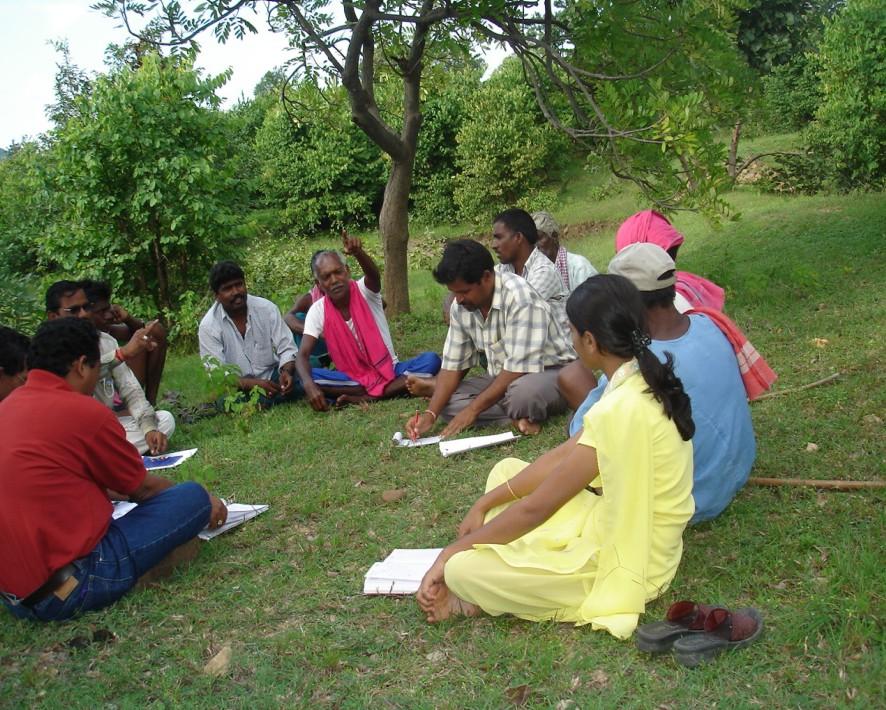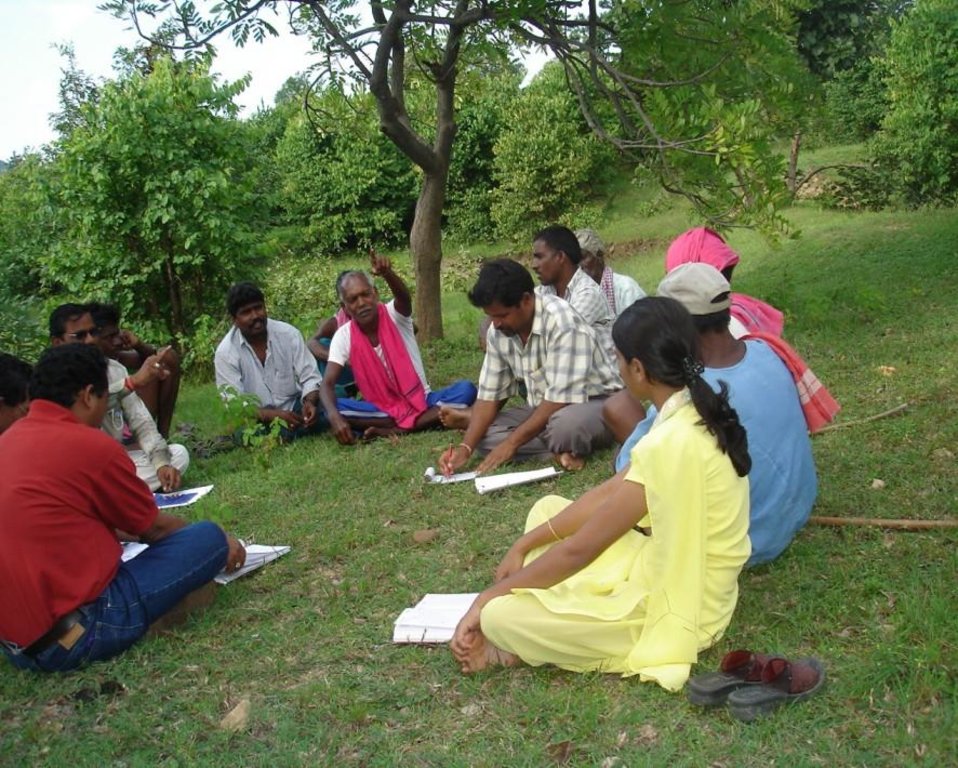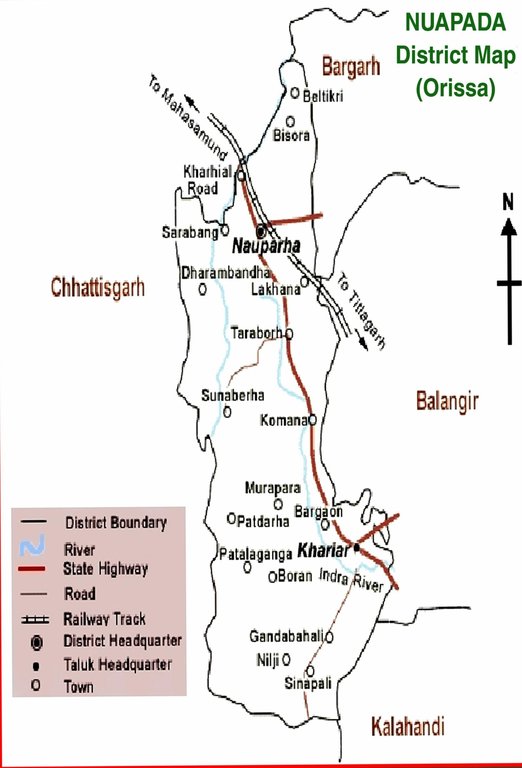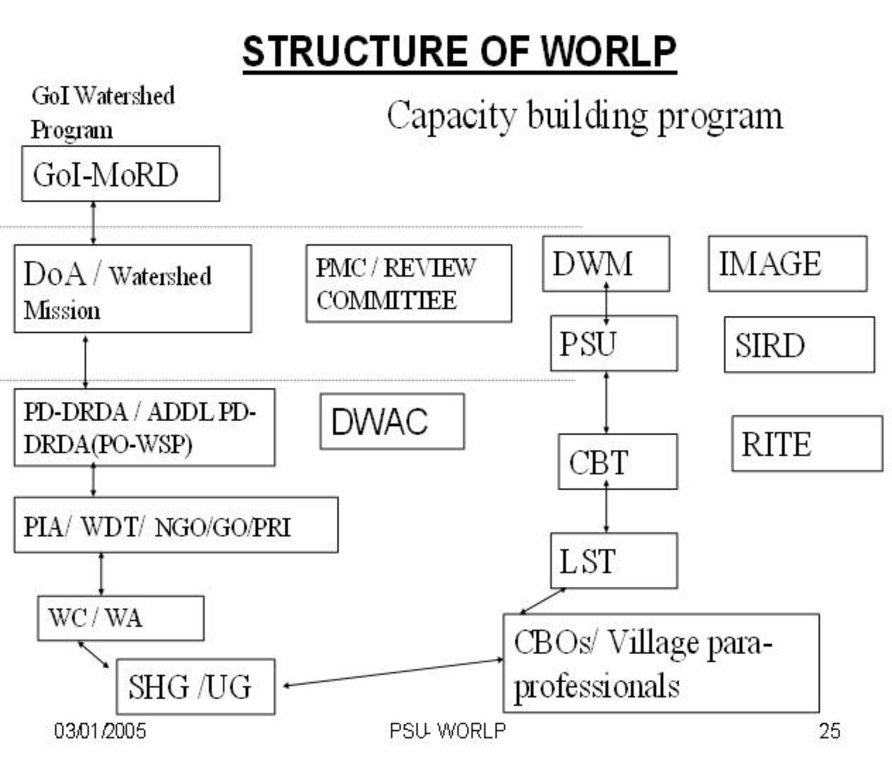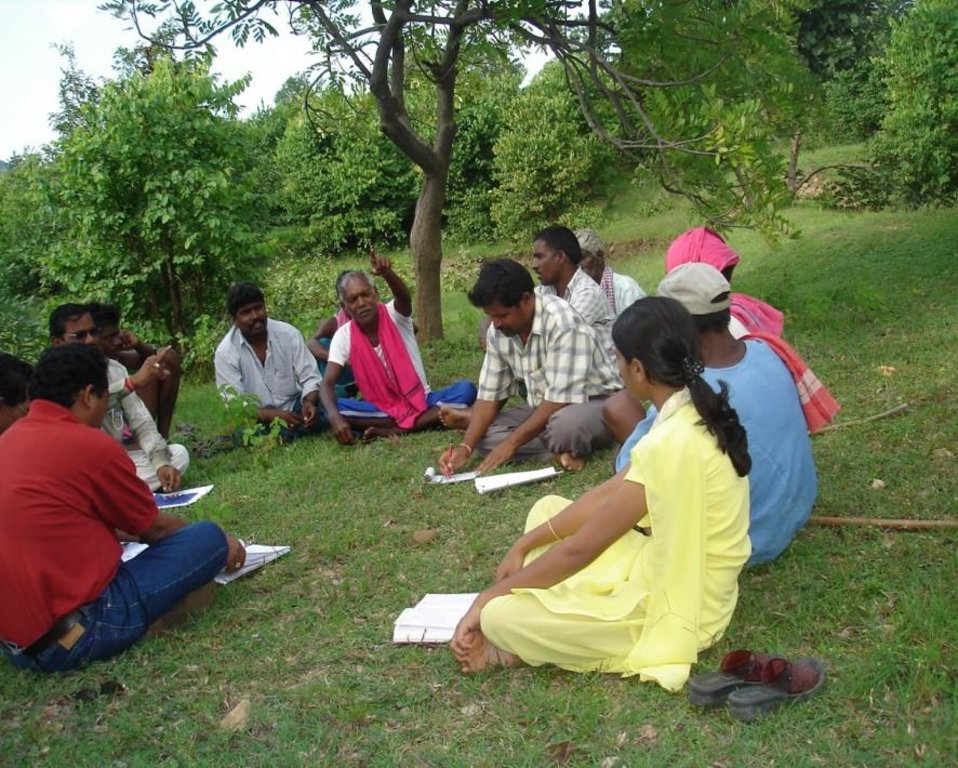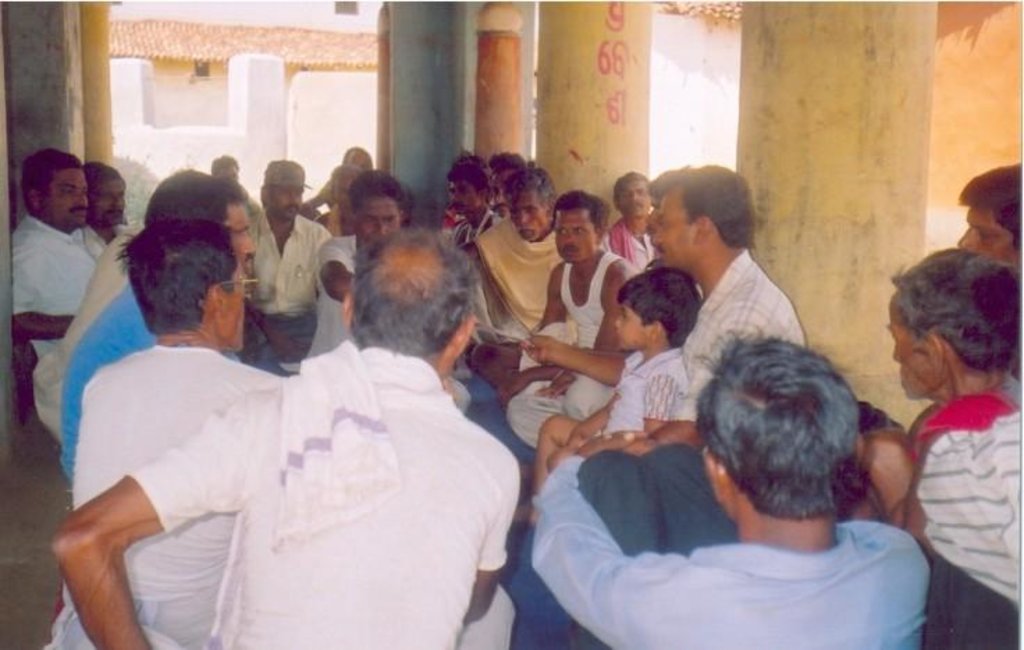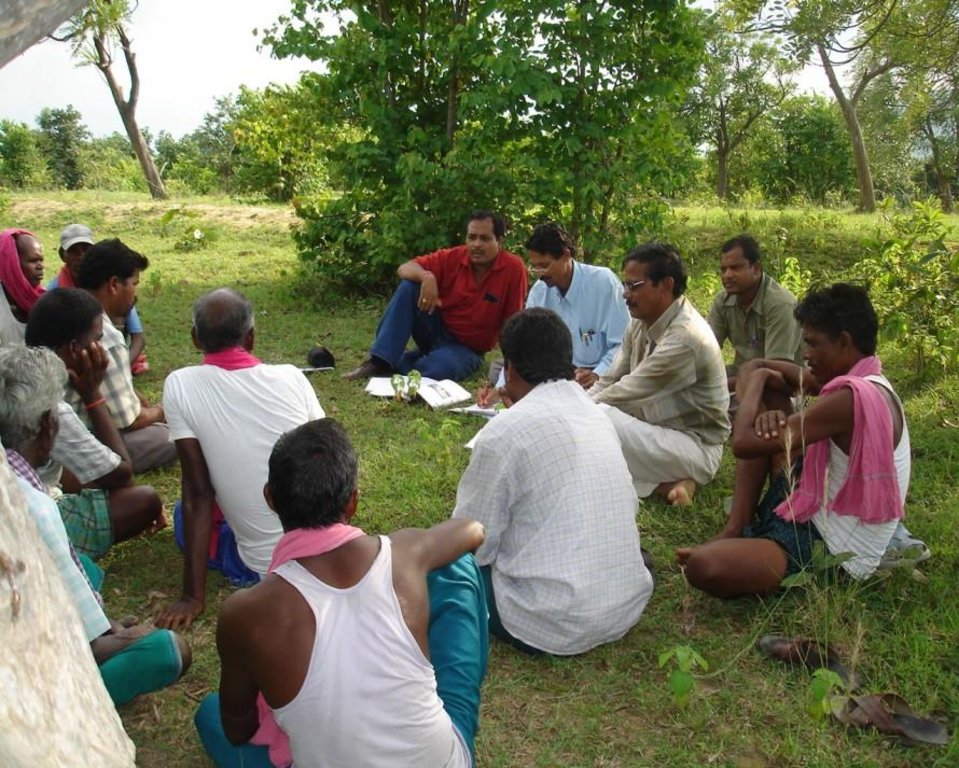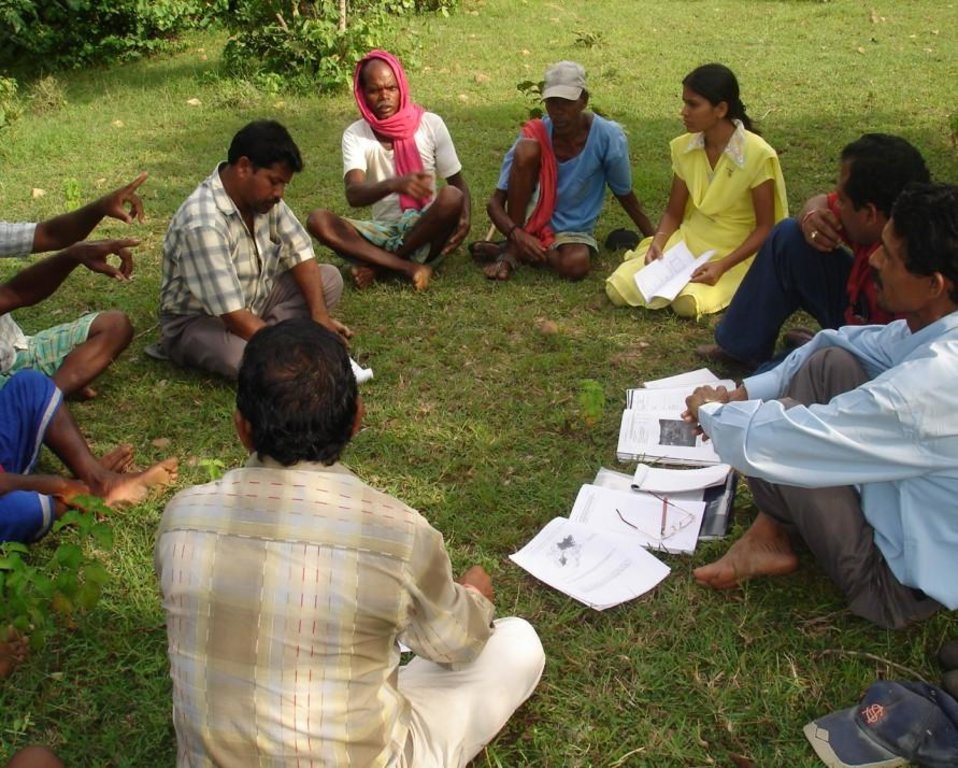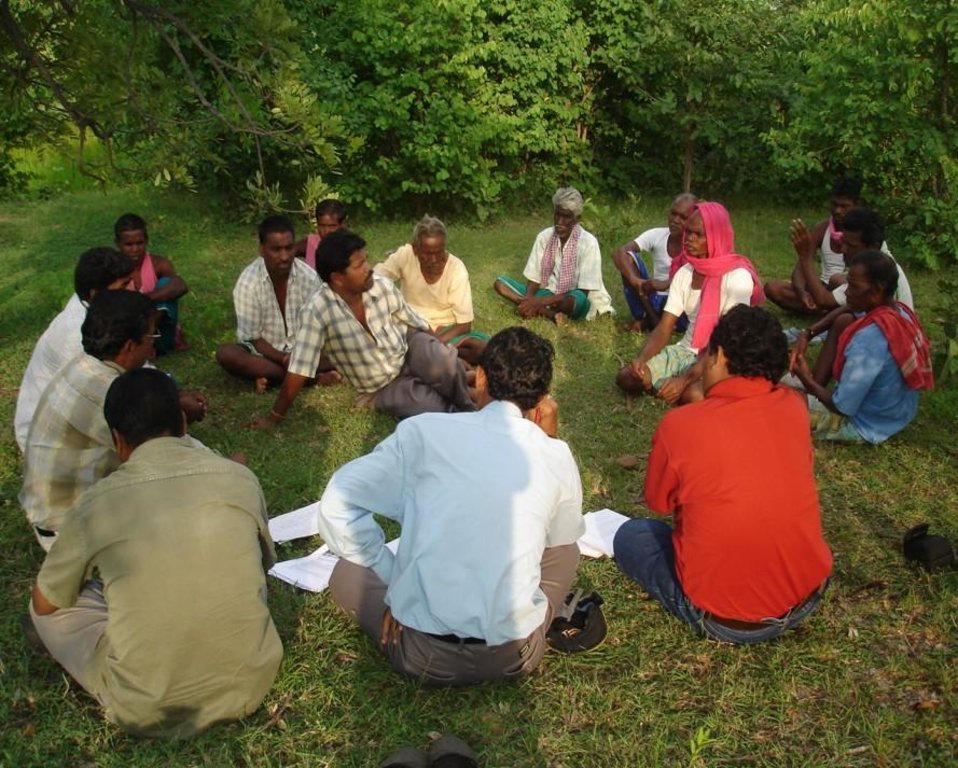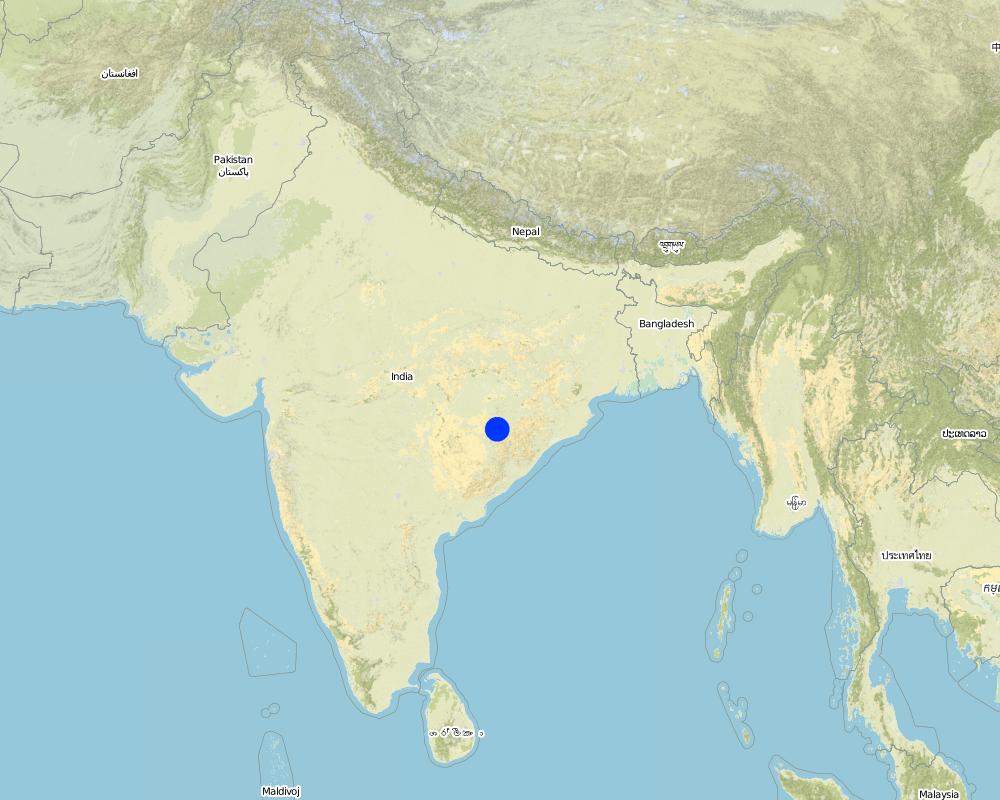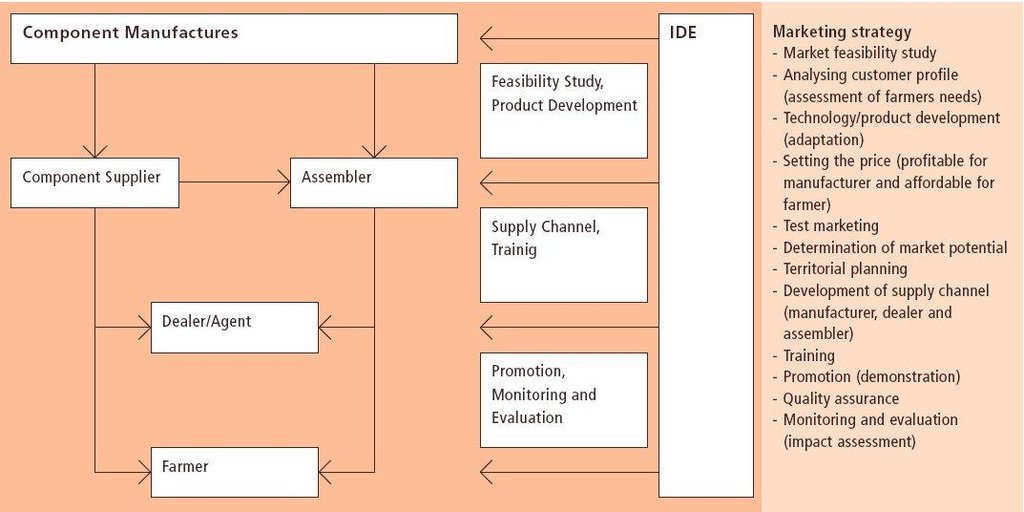Participatory Watershed Development Approach [India]
- Creación:
- Actualización:
- Compilador: Narendra Kumar Panigrahi
- Editor: –
- Revisor: Fabian Ottiger
approaches_2368 - India
Visualizar secciones
Expandir todo Colapsar todos1. Información general
1.2 Detalles de contacto de las personas de referencia e instituciones involucradas en la evaluación y la documentación del Enfoque
Nombre de la(s) institución(es) que facilitaron la documentación/ evaluación del Enfoque si fuera relevante)
Orissa Watershed Developemnt Mission - India1.3 Condiciones referidas al uso de datos documentados mediante WOCAT
El compilador y la/s persona(s) de referencia claves aceptan las condiciones acerca del uso de los datos documentados mediante WOCAT :
Sí
1.4 Referencia/s al/los Cuestionario(s) de Tecnologías MST
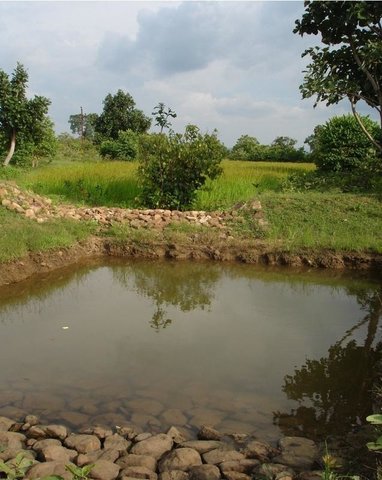
Sunken gully pits [India]
Runoff management pit in the gully with provision of waterway for excess runoff water.
- Compilador: SATYANARAYANA SAHU
2. Descripción del Enfoque MST
2.1 Breve descripción del Enfoque
Livelihood asset base development through participatory watershed developemnt keeping people at the center stage of development and promoting village level institutions.
2.2 Descripción detallada del Enfoque MST
Descripción detallada del Enfoque MST:
Aims / objectives: Livelihoods improvement through asset building; Capacity building, Enabling environment, Village level institutions building, Natural resource management. Participatory tools are used to do situational analysis and planning. Self Help Groups and User Groups are promoted for taking up micro enterprise and land based activities respectively. Community mobilisation is done using local folk songs and dance.
Stages of implementation: The project is implemented within a five year period. First year is used as rapport building, institution building and preparation of micro plan. The external team plays the role of facilitators and capacity building of the primary stakeholders.
2.3 Fotos del Enfoque
2.5 País/ región/ lugares donde el Enfoque fue aplicado
País:
India
Región/ Estado/ Provincia:
Village- Larki, Block- Komna, Dist.- Nuapada.
Map
×2.6 Fechas de inicio y conclusión del Enfoque
Indique año del inicio:
2001
Año de conclusión (si el Enfoque ya no se aplica):
2010
2.7 Tipo de Enfoque
- proyecto/ basado en un programa
2.8 Propósitos/ objetivos principales del Enfoque
The Approach focused mainly on SLM with other activities (Productivity enhancement; Income generating programme, Water and sanitation)
1. Livelihood improvement. 2. Poverty Reduction. 3. Increase households(HH) annual income. 4. Eco restoration
The SLM Approach addressed the following problems: Natural calamity ( drought) 2. Poverty 3. Illiteracy 4. Sustanability in agriculture production.5. Economic enhancement of the people.
2.9 Condiciones que facilitan o impiden la implementación de la/s Tecnología/s aplicadas bajo el Enfoque
normas y valores sociales/ culturales/ religiosos
- impiden
Education, personal conflict, lack of knowledge, skill
Treatment through the SLM Approach: IEC material, Training,Hand holding support.
disponibilidad/ acceso a recursos y servicios financieros
- impiden
Poor financial status of theof community.
Treatment through the SLM Approach: Financial Assistance from the project with little contributioin from the beneficiaries
entorno institucional
- impiden
Ugs not functional as desired
Treatment through the SLM Approach: strengthening of the Ugs
marco de trabajo legal (tenencia de tierra, derechos de uso de tierra y agua)
- impiden
No usufruct right/ownership on CPR land
Treatment through the SLM Approach: Users right/ usufrut right to the UG
The existing land ownership, land use rights / water rights hindered a little the approach implementation Fragmentated land ownership with low land holding dinder the implementation of the approach.
conocimiento de MST, acceso a apoyo técnico
- impiden
Unable to perceive real problem because of technical failures
Treatment through the SLM Approach: Technical problem analysis with the community
3. Participación y roles de las partes interesadas involucradas
3.1 Partes interesadas involucradas en el Enfoque y sus roles
- especialistas MST/consejeros agrícolas
Working land users were mainly men (Most men are engaged in landbased activities.) Women are not capacitated to putforth their views in community meeting. Women are not free enough to say something due to socio-cultural hindrance. Women are not empowered to participate along with the men in public meeting. As per the guideline Land Less(LL) and Very Poor (VP) are included in Watershed Development Committee(WDC) for decision making.
- ONG
- gobierno nacional (planificadores, autoridades)
Govt. agency
- organización internacional
3.2 Involucramiento de los usuarios locales de tierras/ comunidades locales en las distintas fases del Enfoque
| Involucramiento de los usuarios locales de tierras/ comunidades locales | Especifique quién se involucró y describa las actividades | |
|---|---|---|
| iniciación/ motivación | pasivo | public meetings; Lack of awareness about the SWC measures. |
| planificación | interactivo | Mainly: rapid/participatory rural appraisal; partly: interviews/questionnaires; Conceptual clarity regarding SWC & its benefits |
| implementación | apoyo externo | Mainly: casual labour; partly: responsibility for minor steps; Engaged as daily wage labourer. Extends cooperation in non-monetary activities |
| monitoreo y evaluación | interactivo | Mainly: public meetings; partly: interviews/questionnaires; 1. Evaluation of field work through measurement. 2. Transperancy on expenditure and programme. |
| Research | pasivo |
3.3 Flujograma (si estuviera disponible)
3.4 La toma de decisiones en la selección de Tecnología(s) MST
Especifique quién decidió la selección de las Tecnología/ Tecnologías a implementarse:
- principalmente usuarios de tierras con el apoyo de especialistas MST
Explique:
The problems are discussed while doing transect in the watersheds. Solutions aby the users as well as the SWC specialists are discussed. The consensus is arrived on the technology which land users can accept, adopt and maintain.And the technology do not put pressure on the natural environment.
Decisions on the method of implementing the SLM Technology were made by mainly by land users supported by SLM specialists. During the MLP,transect is carried along with the land users and options were discussed with the land users. Then they choose the best option after analysing the opportunities and constraints.The UG implement the technology. This has been laid down in t
4. Apoyo técnico, fortalecimiento institucional y gestión del conocimiento
4.1 Construcción de capacidades / capacitación
¿Se proporcionó la capacitación a usuarios de tierras/ otras partes interesadas?
Sí
Especifique quién fue capacitado:
- usuarios de tierras
- SWC specialists, teachers (2), extensionists/trainers (1), planners (3)
Forma de capacitación:
- en el contexto de trabajo
- de agricultor a agricultor
- áreas de demostración
Temas avanzados:
Class room as well as on farm training provided to land users.
4.2 Servicio de asesoría
¿Los usuarios de tierras tienen acceso a un servicio de asesoría?
Sí
Especifique si servicio proporcionado se realizó:
- en centros permanentes
Describa/ comentarios:
Name of method used for advisory service: Participatoy extension methods and exposure to successful fields, demo plotsl; Key elements: Seeing is beleiving and learning by doing; 1) Mainly: Through change agents(Community Link Workers), Partly: government's existing extension system 2) Mainly: Through change agents(Community Link Workers), Partly: government's existing extension system; Extension staff: specifically hired project employees 3) Target groups for extension: land users; Activities: To expertise and replicate
Advisory service is inadequate to ensure the continuation of land conservation activities; Extensioin programme relating to production aspects of the technology is not adequate.
4.3 Fortalecimiento institucional (desarrollo institucional)
¿Se establecieron o fortalecieron instituciones mediante el Enfoque?
- sí, moderadamente
Especifique el nivel o los niveles en los que se fortalecieron o establecieron las instituciones:
- local
Especifique el tipo de apoyo:
- financiero
- construcción de capacidades/ entrenamiento
- equipo
4.4 Monitoreo y evaluación
¿El monitoreo y la evaluación forman parte del Enfoque?
Sí
Comentarios:
bio-physical aspects were regular monitored through observations
technical aspects were regular monitored through measurements
socio-cultural aspects were regular monitored through observations
economic / production aspects were regular monitored through measurements
area treated aspects were regular monitored through observations
no. of land users involved aspects were regular monitored through measurements
management of Approach aspects were regular monitored through observations
There were few changes in the Approach as a result of monitoring and evaluation: Increased participation and ownership. User groups are strengthened. Viewsa of the Users respected and involved in decision making.
4.5 Investigación
¿La investigación formó parte del Enfoque?
Sí
- Participatory and action research
Proporcione detalles adicionales e indique quién hizo la investigación:
Participatory technology development through IDEI and action research with independent consultancy firms have been initiated. But relating to approach research study have not been initiated. This is infant stage.
Research was carried out on-farm
5. Financiamiento y apoyo material externo
5.1 Presupuesto anual para el componente MST del Enfoque
Si no se conoce el presupuesto anual preciso, indique el rango:
- 10,000-100,000
Comentarios (ej. fuentes principales de financiamiento/ donantes principales):
Approach costs were met by the following donors: government (national - MoRD): 100.0%
5.2 Apoyo financiero/material proporcionado a los usuarios de tierras
¿Los usuarios de tierras recibieron financiamiento/ apoyo material para implementar la Tecnología/ Tecnologías? :
Sí
5.3 Subsidios para insumos específicos (incluyendo mano de obra)
- equipo
| Especifique qué insumos se subsidiaron | En qué grado | Especifique los subsidios |
|---|---|---|
| herramientas | parcialmente financiado | |
- agrícola
| Especifique qué insumos se subsidiaron | En qué grado | Especifique los subsidios |
|---|---|---|
| Biocides | parcialmente financiado | |
- infraestructura
| Especifique qué insumos se subsidiaron | En qué grado | Especifique los subsidios |
|---|---|---|
| community infrastructure | parcialmente financiado | |
Comentarios:
UG
5.4 Crédito
¿Se proporcionó crédito bajo el Enfoque para actividades MST?
No
6. Análisis de impacto y comentarios de conclusión
6.1 Impactos del Enfoque
¿El Enfoque ayudó a los usuarios de tierras a implementar y mantener Tecnologías MST?
- No
- Sí, un poco
- Sí, moderadamente
- Sí, mucho
The SWC measures are maintained by the land users. The utilisation of water resource through adoption of cropping systems. Multiple cropping adopted in stead of mono cropping.
¿El Enfoque mejoró cuestiones de tenencia de tierra/ derechos de usuarios que obstaculizaron la implementación de la Tecnologías MST?
- No
- Sí, un poco
- Sí, moderadamente
- Sí, mucho
Community mobilisation & participatory planning reduces the problem to some extent.Group activities are initiated to strengthen community. The problem is likely to be overcome in the near future.
Did other land users / projects adopt the Approach?
- No
- Sí, un poco
- Sí, moderadamente
- Sí, mucho
Other watershed project have replicated the best pracitces adopted in this approach.
6.3 Sostenibilidad de las actividades del Enfoque
¿Pueden los usuarios de tierras sostener lo que se implementó mediante el Enfoque (sin apoyo externo)?
- sí
6.4 Fortalezas/ ventajas del Enfoque
| Fuerzas/ ventajas/ oportunidades desde la perspectiva del usuario de la tierra |
|---|
| Views and opinion of the beneficiaries are considered (How to sustain/ enhance this strength: Regular follow- up.) |
| Fuerzas/ ventajas/ oportunidades desde la perspectiva del compilador o de otra persona de referencia clave |
|---|
| 1.Community Organisation (How to sustain/ enhance this strength: Strengthen village level institutions) |
| 2. Participatory Approaches (How to sustain/ enhance this strength: Institutionalise processes) |
| 3. Monitoring (How to sustain/ enhance this strength: Strengthen community monitoring) |
| 4. Evaluation (How to sustain/ enhance this strength: Evaluation by both internal and external agency) |
| 5. Ownership (How to sustain/ enhance this strength: User rights ensured, Community Fund Sustainably utilised) |
6.5 Debilidades/ desventajas del Enfoque y formas de sobreponerse a ellos
| Debilidades/ desventajas/ riesgos desde la perspectiva del usuario de la tierra | ¿Cómo sobreponerse a ellas? |
|---|---|
| Coherence among group members | How to make the groups self sustainable? This needs to be addressed by providing financial freedom, decision making opportunities,vision building through exposure to better groups |
| Debilidades/ desventajas/ riesgos desde la perspectiva del compilador o de otra persona de referencia clave | ¿Cómo sobreponerse a ellas? |
|---|---|
| Facilitators attitude | Capacity building programme for the facilitators |
7. Referencias y vínculos
7.1 Métodos/ fuentes de información
- visitas de campo, encuestas de campo
- entrevistas con usuarios de tierras
Vínculos y módulos
Expandir todo Colapsar todosVínculos

Sunken gully pits [India]
Runoff management pit in the gully with provision of waterway for excess runoff water.
- Compilador: SATYANARAYANA SAHU
Módulos
No se hallaron módulos


